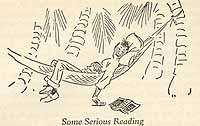

- Grand Bahama in 1887 from L. D. Powle The Land of the Pink Pearl or Recollections of Life in the Bahamas.
- Grand Bahama in 1891 from Stark's History and Guide to the Bahama Islands.
- Grand Bahama in 1917 from Amelia Defries In a Forgotten Colony
- Grand Bahama in 1924 from The Tribune Handbook
- Grand Bahama in 1926 from Mary Mosley The Bahamas Handbook.
- Grand Bahama in 1931 from Nassau and the Treasure Islands of the Bahamas
- Grand Bahama in 1934 from Maj. H. M. Bell Bahamas: Isles of June
- The Bahamas in 1964 from Benedict Thielen The Bahamas-Golden Archipelago
- Grand Bahama in 1967 Moral Panic, Gambling. and the Good Life
Grand Bahama in 1926
Grand Bahama, which gives its name to the group, lies to the south of Little Bahama Bank and is the largest island opposite the mainland, being only 60 miles from the Florida Coast off Palm Beach. It comprises about 430 square miles. It was not permanently settled until about 1806, although it was resorted to by the woodcutters of the other islands for the fine timber with which it abounded. The soil along the seaboard is "white land" and yields fair crops of corn. The interior is well adapted to grazing, fresh water being abundant. Large quantities of fish and turtle are to be found in the creeks and shaol water. The inhabitants are principally employed in agriculture, sponging and fishing. There are no good harbours along the shore for large vessels, but with the wind off of the land the anchorage is good, particularly at the west end.
Eight Mile Rock, which from Hawksbill Creek, a most picturesque inlet, runs three miles nort and south, is the chief settlement, but in the last few years considerable business has been done at West End which has been made a port of entry. A large scheme for the development of the island has recently been launched by the Grand Bahama Merchantile and Development Company.
The population of Grand Bahama is 1,695, a decrease of 129 since 1911. With Bimini, Grand Bahama sends one membe4r to the House of Assembly.
Mosley, Mary. The Bahamas Handbook. Nassau: The Nassau Guardian, 1926. P. 61-62
